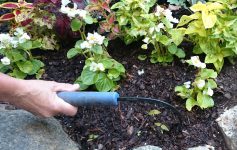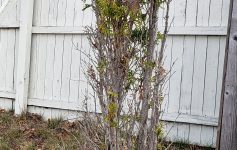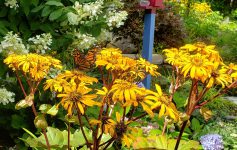A “meaningful” garden (the definition of meaningful is strictly that envisioned by the garden owner) takes time, hours of sweat, work, tears and celebration…much as any valued activity in life. It is often not easy to secure the outcomes you had envisioned…but when it all comes together at bloom time or the harvest…ahhh…. the rewards are plentiful.
In our fast paced society we may often think speed and the concept of “one size fits all” can apply to gardening. One of the very first practice principles I learned as a master gardener is “right plant-right place”. In my garden journeys…deviating from this concept has always resulted in disappointment. I observed for many years a property on 9N plant 3 foot arbor vitaes in half barrels roadside each spring…and the following spring these shrubs were deader than a door nail! This same practice went on for 5 years..until this year…they gave up and took away the barrels!
So what does right plant-right place mean? Essentially all plants/shrubs/trees have particular habitat requirements and growing qualities. Therefore meeting those in the environment of choice and your design…will create a happy plant and a loyal relationship in your gardens.
Plants, like people have particular characteristics, height, width, feeding requirements (e.g. fertilizer, water and soil type), need for sun, resistance to disease, insects and the like, as well as type and season for bloom. In keeping your garden green, you will want to research this when you plan out your gardens. Where do you find such information? Most folks will do a Google search on the internet. that is fine…but when you plug in your plant name…and the results come up…make sure you look carefully at the pop up sources and compare a few to make sure they are all saying the same thing about the plant. Top dog on the Google list is not always the most reliable!
Another good way to match plants with the right space is the plant tag in the pot. Very much like the use and care label you find in clothing, this tag will have tons of information about the plant. Many of my nursery garden plants have a “pick a plant” tag from the grower which makes plant selection simple. On it you will find the sunlight requirements for the plant. Does it require full sun: more than 6 hours of direct sunlight during the growing season. Or is it part sun: more than 3 hours of sun but less than 6. Or is it happier in shade which is basically less than 3 hours of sun and no direct afternoon sunlight. You can fudge the light requirements with some plants to a degree…but understand you will not get peak performance. This often will result in little to no bloom or reduction in the colors of the leaves. A good example is the dwarf Japanese maple. If will tolerate part sun…but the brilliance of the red leave may be compromised. And with some evergreens,,, may look good for a few years…but die a slow death over the years due to lack of required sunlight.
The plant tag may also give you information about the height and width of the mature plant. So you can place a plant appropriately in your design first time…without having to worry about it becoming too large for the space. I see this constantly when I travel out to restore old gardens. Huge overgrown or invasive style plants take over the space as its growing habits were not considered at the design onset.
And lastly…look at the hardiness identification number for the plant…I usually go with plants that are zoned for 5 and below…generally look at hardy to -10 degrees to 0 degrees F. This is a good measure for most of Saratoga County. Of course you will be able to squeak in a few zone 6 plants in the more urbanized areas with high degrees of heat absorbing buildings and hardscapes. And of course winters can deliver little to no snow cover whipping winds and long periods of severe temperatures that will blow this whole zone application away. Due to winter conditions last year…I lost many long standing compatibly zoned shrubs in my landscapes early spring as a result of such conditions. Yes, just as life can throw you a curve…so can the weather for our gardens.
So my advice for keeping green sustainable…do a little research on your plant material BEFORE you purchase and dig in. Your time and investment will be well spent, giving you more joy than garden headaches!



